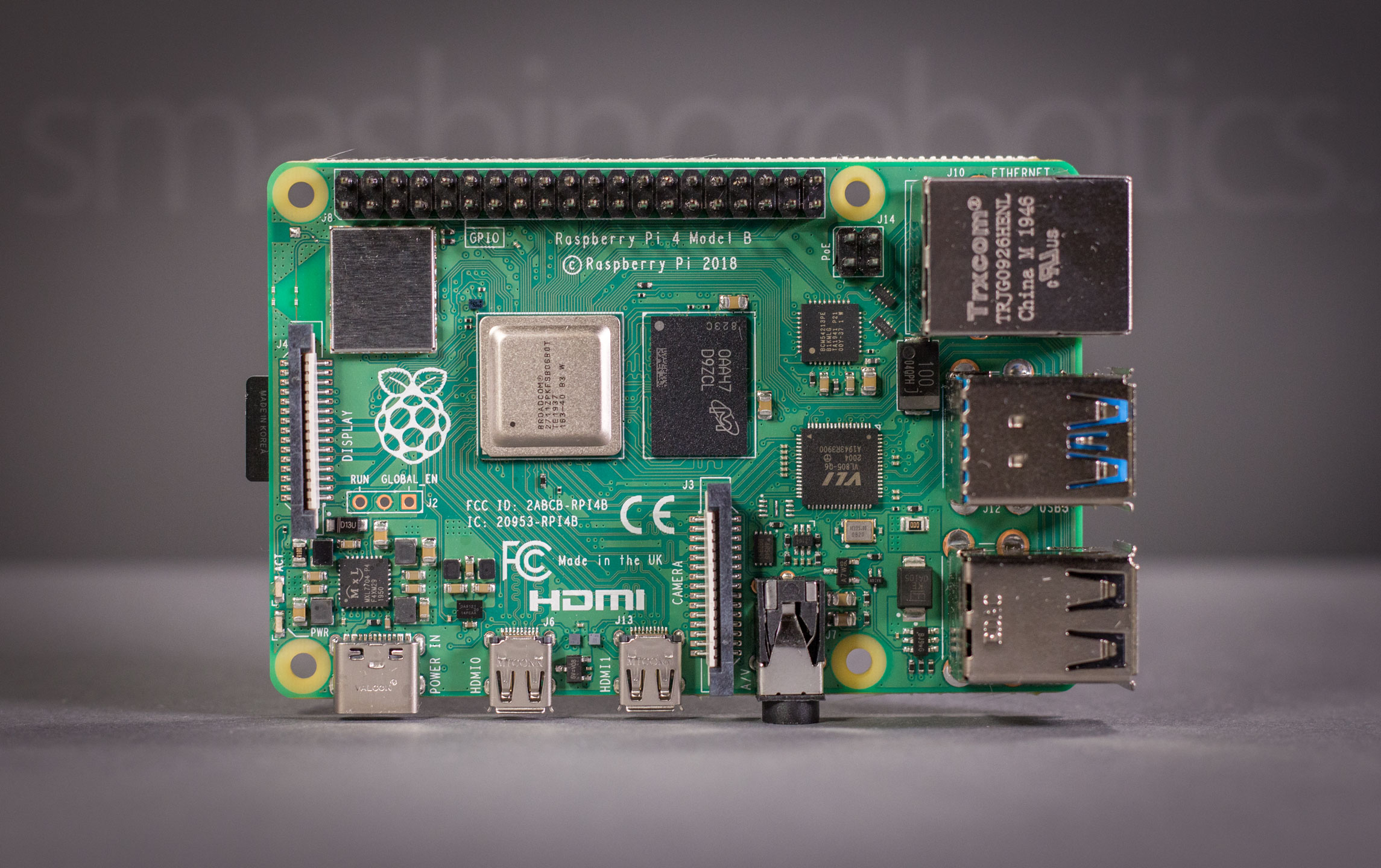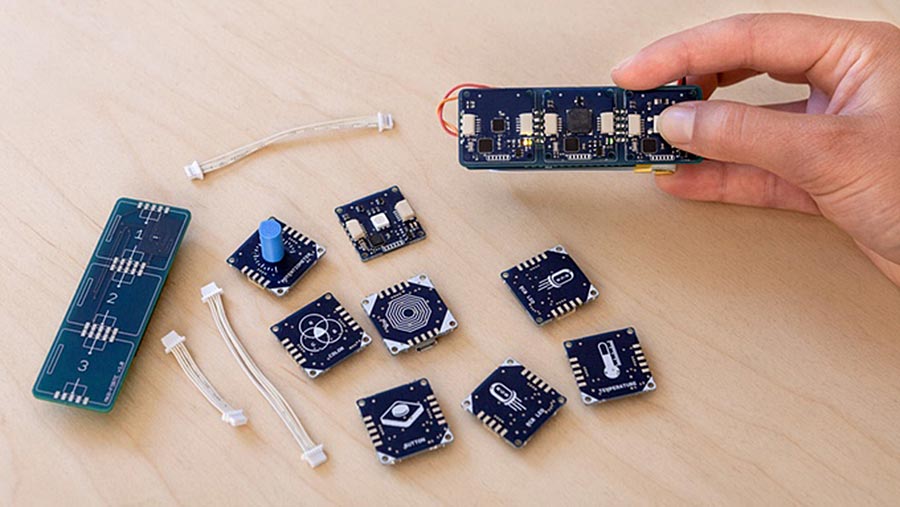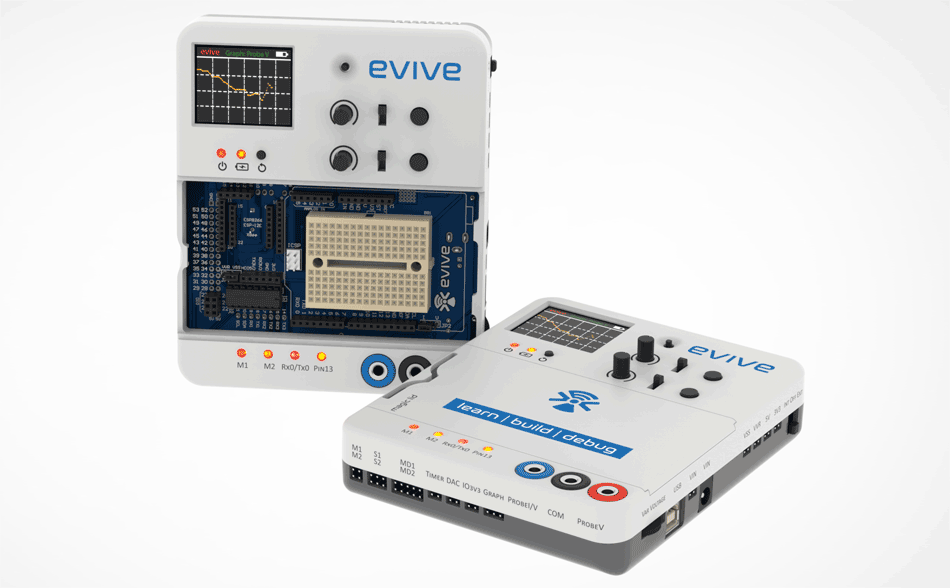Electrical power is the most common source of energy in mobile robotics. Electrical power systems are cheap, practical, easy to implement and can be used in any environment – even indoors, as no pollution takes place locally. However electricity is used up at some time, at this point shortcomings of these systems come into play, long recharging times or bulkiness for large capacity systems to name just a few. A way to constantly regenerate power, or at least to slow down depletion of energy resources is needed. In the following we will take a look at elements which could be used to build electrical power sources for robots.
Rechargeable Batteries
Lead-Acid (Pb-Acid) Battery
The rechargeable battery, or secondary cell, that can be recharged by reversing the chemical reaction has been invented in 1859 by french physicist Gaston Plante. Plante’s cell was the lead-acid battery, used on a massive scale nowadays. The lead-acid battery has three or six cells, with a voltage of 2V per cell, connected in series and it is used in a wide range of vehicles, from automobiles or bikes to airplanes. Its great advantage is that it can provide strong current to start an engine even though its capacity is limited.

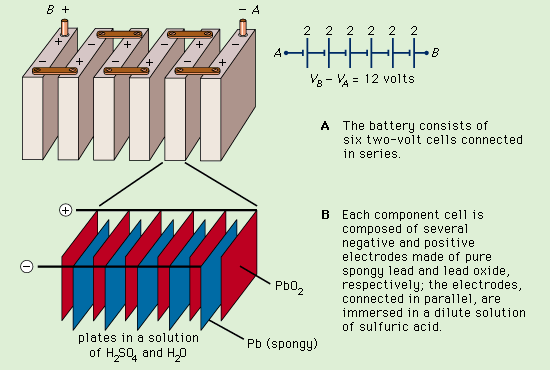
The electrolyte is a diluted sulphuric acid solution, the negative electrode is made of lead and the positive electrode is made of lead dioxide. During use the negative electrode is separated into electrons and positive lead ions. The electrons pass through the external electrical circuit while the positive ions combine with sulfate ions in the electrolyte and form lead sulfate. When electrons reenter the cell at the positive electrode another chemical reaction takes place, the lead dioxide combines with hydrogen ions in the electrolyte to form water, releasing lead ions into the electrolyte to form again lead sulfate.
A lead-acid battery is discharged when the sulphuric acid is turned completely into water and the electrodes in lead sulphate. When the battery is recharged, the chemical reactions described earlier take place in a reversed order, until chemicals are returned to their original state. A lead-acid battery has a lifespan of four years. In the light of recent developments, batteries for certain applications have been made with a lifespan of 50 to 70 years.
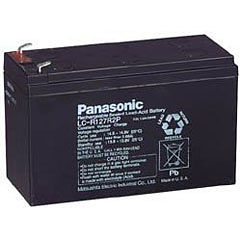
Nickel-Iron (Ni-Fe) Battery
Another common type of battery is the alkaline cell, or nickel-iron battery, developed by the american inventor Thomas Edison in the years 1900. The principle of operation is similar to the lead-acid battery, in this case the electrolyte is a potassium hydroxide solution, the negative electrode is made of iron and the positive is made of nickel oxide.
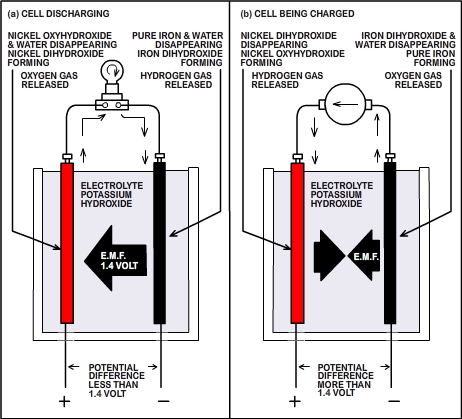
| Ni-Fe cell schematics | Source |
A disadvantage of the Ni-Fe cell is that, when recharging, hydrogen is externally eliminated as gas. This cell has a lifespan of ten years and generates around 1,15V.
Nickel-Cadmium (Ni-Cd) Battery
Another alkaline cell type, similar to the above, is the Ni-Cd battery, in which the negative electrode is made of cadmium. It also generates approximately 1,15V and its lifespan can reach 25 years.


A large number of developments have been made in the field of rechargeable batteries as electric vehicles have become more popular. Despite the improvements made, rechargeable batteries still haven’t overcome their disadvantages in terms of reduced power, high price, bulkiness or environment pollution problems. Sealed rechargable lead-acid batteries are a viable solution in alternate power supply systems. Their lifespan ranges between 4 and 6,5 years and they offer reasonable performance in small, medium and some large mobile robot applications, with capacities ranging up to 42-65 Ah per unit.
Solar Power Systems
The Sun generates a huge amount of energy which is dissipated in Space, only a small fraction of this energy reaching Earth in the form of light and other radiations. Solar energy is, in principle, pretty easy to use, it is captured directly from the Sun and stored.
A solar power generator is comprised of two main parts: a collector unit, which receives incident radiation and converts a fraction of it into other forms of energy, electricity or heat and a power storage unit in which captured energy is stored. It is not an absolute requirement for a solar power system to have a storage unit but power availability will greatly depend to the highly variable amount of energy reaching the collector.
There are three types of collectors: flat plate, focusing and passive units.
Flat plate collectors
These are the most common type. They are actually solar panel matrices laid out on a flat surface. Almost any dimension is possible and the amount of generated energy directly depends on size, orientation and degree of cleanliness as these factors dirrectly affect the amount of incident radiation received. In many cases these collectors also have automatic sunlight orientation systems to maximize efficiency.
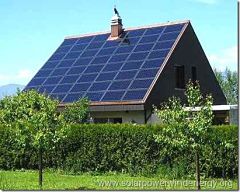
Focusing collectors
These are essentially flat plate connectors onto which auxiliary optical systems help focusing and thus maximizing the amount of incident radiation. This type is not very common and has several shortcomings, unlike flat plate collectors they do not receive radiation reflected from the soil, which can be significant in certain cases, and can reach very high temperatures, affecting the efficiency of silicon elements or even damaging them.


Passive collectors
are completely different from the other two types of collectors. These collectors absorb radiation and convert it into heat in a natural fashion, without necessarily being conceived for such purpose. All objects have the capacity to do this, to some extent, but only certain elements can be efficient in the process. In many cases the natural capacity of an element to convert radiation into heat can be augmented, e.g. painting the object in a dark color, then a system to transfer heat to another location can be added.
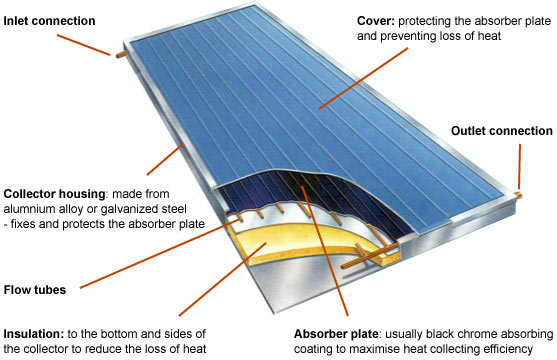
| Domestic hot water solar panel | Source |
Solar panels
Photovoltaic cells represent the building blocks of any solar panel. The cells convert radiation into electricity but operate with a theoretical efficiency of 32%, the real-life efficiency being only around 15%, not very efficient from an economics standpoint. During recent developments an efficiency of around 28% has been reached in lab conditions, but real-life performance has yet to be proved.
Photons in the incident light hit the cell, but only photons with a certain level of energy can set free electrons from the atomic bonds in the cell’s material, thus generating electrical current. This level of energy, known as dislocation energy, is defined as the quantity of energy required to set free an electron in a covalent bond, sending it into an electrical circuit. Photon energy must be at least equal to the dislocation energy in order for a photon to set free an electron. If high-energy photons hit the photovoltaic cell, energy that is not used by the the electron dislocation process is converted into heat, an efficient cell being the one that can convert as much photon energy as possible into electrical energy, not lose it to heat. Dislocation energy levels vary between 1 to 1,6 eV (electron-volts) in efficient photovoltaic semiconductors.
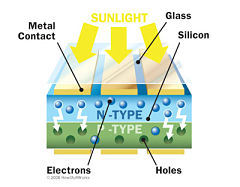
An individual photovoltaic cell can generate a power of 1-2 W, very little for most applications. Power can be increased by connecting multiple cells together into arrays called “modules”, with power ratings from 5 to 300 W. These modules can be linked together even further into large units called “matrices” and so on, this being the method for building a photovoltaic system that meets desired power requirements.
Classifications
The material of choice in photovoltaic cells manufacture is silicon, although several other materials can be used.
There are two types of cells, crystalline and thin-film. Crystalline cells are very common and are made out of slices cut from silicon crystal billets, while in the case of thin-film cells, photovoltaic material is deposited in thin layers, 0,001 to 0,2 mm thick, on substrate layers made of glass, stainless steel or plastic. The working principle of the latter is similar to a diode, semiconductor layers in the thin-film cells being doped with electrons in order to form p and n junctions.
A more detailed classification:
Monocrystalline silicon (mono-Si) cell
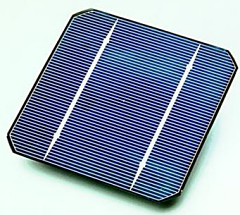
Efficiency: 15-20%; Construction: single and continuous crystal with almost no defects; Has a global market share of 42%, it is a very stable and well-known manufacturing method, yet the production process is long and intricate.
Polycrystalline silicon cell
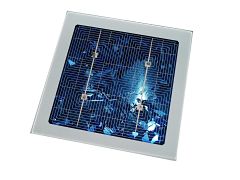
Efficiency: 9-16%; Construction: multiple single crystal granules cast in billet; Has the advantage of a more rapid production and is a relatively well-known fabrication method.
EFG (Edge-defined Film-fed Growth) silicon cell

Efficiency: 10-13%; Construction: crystalline silicon grown in blocks and in thin layers; A very economical and well-known manufacturing process, yet the global market share is only 3%.
Amorphous Silicon (a-Si) cell

Efficiency: 4-7%; Construction: non-crystalline silicon; Despite having a very low efficiency it is relatively popular (12% market share) in low-power consumer applications (pocket calculators, watches, etc.) thanks to its low production cost.
CIS/CIGS, CdTe cells
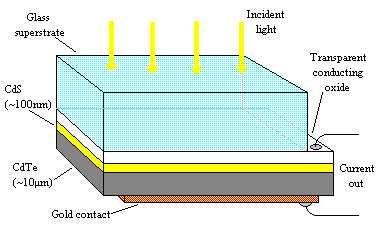
Efficiency: 7-10%; Construction: CuInGa(2) semiconductor material and CdTe (tellurium – rare material) crystalline compound sandwiched between CdS layers; These types can be produced very rapidly yet techonogy is still experimental, market share 1%.
- Structure and reaction formulas of batteries, Battery Association of Japan
- Ni-Fe cell chemistry
- Ni-Cd batteries, Unitech manufacturer
- Solar water heating, Volker Quaschning
- Solar energy conversion diagrams, Solar Energy Facts
- Solar hot water collectors, GreenSpec
- How to make solar panels, Renewable Energy Blog
- Solar cell types, Norwegian University of Science and Technology
- What is a solar cell
- CdS/CdTe solar cell information and research, Durham University
- Photovoltaic cell operation, HowStuffWorks
- Kyocera, solar panel manufacturer


